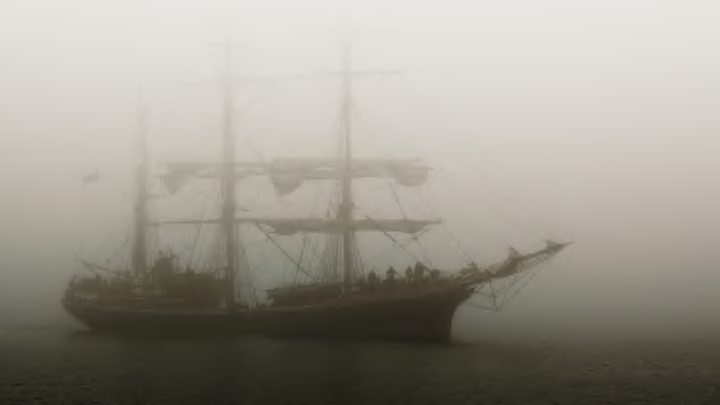In early December 1872, the crew of the English cargo ship Dei Gratia made a perplexing discovery in the Atlantic. The Dei Gratia’s helmsman spotted a ship a few miles off his bow and quickly realized that it was a familiar brigantine, the Mary Celeste. Something seemed a little off, though. The ship’s sails were up, but they appeared to be lopsided and torn. Furthermore, while the Mary Celeste appeared to be heading for the Strait of Gibraltar, the ship wasn’t really keeping a straight course.
The concerned helmsman headed to intercept the apparently troubled ship, and when the Dei Gratia finally caught up to the other vessel after hours of observation, they discovered one of history’s greatest mysteries: the entire crew of the Mary Celeste had vanished.
The Mystery on Board the Mary Celeste
Oliver Deveau, the Dei Gratia’s chief mate, was the first sailor to board the eerily quiet ship. After poking around the decks and the holds, Deveau reported back that although the Mary Celeste was a “thoroughly wet mess” with quite a bit of standing water below decks and in the bilge, the ship was still seaworthy. But there wasn’t a soul on board. The entire crew and Captain Benjamin Briggs, along with Briggs’s wife and 2-year-old daughter, were nowhere to be found.
The baffled crew of the Dei Gratia decided to split up and sail the Mary Celeste to Gibraltar. Once they arrived safely, the British Vice Admiralty Court began an inquiry into the Mary Celeste’s abandonment, and the ghostly ship became a worldwide media sensation.

The Admiralty inquiry lasted three months and tested all sorts of theories. One of the early explanations that got quite a bit of traction—even The New York Times reported it—was that the ship had been attacked by pirates who murdered the crew. There were a few problems with that story, though. Piracy wasn’t particularly common in that part of the world at the time thanks to a strong British naval presence, and there wasn’t any sign of a struggle on the Mary Celeste. Plus, pirates generally didn’t just take a boat, kill the crew, and then leave it adrift at sea with a hold full of cargo.
Another explanation—also reported by The New York Times—hypothesized that the ship’s crew had gotten into the alcoholic cargo and then murdered Captain Briggs and his family during a drunken rampage before fleeing in the lifeboat. (TheTimes reported that “some of the men probably obtained access to the cargo, and were thus stimulated to the desperate deed.”) That story didn’t work with the facts either. The crew had all been experienced sailors with impeccable records, and the alcohol in the hold was denatured, not the sort of drinkable grade-A booze that might incite a mutiny. Moreover, despite a search for the crew in ports around the world, not a single member ever turned up.
What Really Happened to the Mary Celeste?
When these mundane explanations proved to be dead ends, conspiracy theorists became increasingly fantastic with their stories: What if a sea monster had devoured the crew? Wasn’t this mysterious disappearance obviously the work of aliens? Perhaps the ship’s flour had become contaminated with hallucinogenic ergot fungus and caused the entire crew to throw themselves overboard in a fit of collective madness. As one might imagine, nobody found these far-fetched theories all that compelling.
Today there are a few prevailing theories about what really happened to the crew of the Mary Celeste. Some historians now believe that the ship hit a waterspout—a tornado at sea—that caused the vessel to take on water. Although the Mary Celeste was still seaworthy, Captain Briggs may have panicked and abandoned ship, only to have the lifeboat sink in the storm.
Another credible theory centers on the ship’s dangerous cargo. When investigators unloaded the 1701 barrels of alcohol from the hold, nine barrels turned out to be empty. These barrels were made of porous red oak, which might have allowed alcohol vapors to gradually escape until there was a small but terrifying explosion below decks. Such an explosion—or even the presence of vapors that might have exploded—could have spooked the crew into the abandoning the ship before it went up in flames.
The Mary Celeste eventually found a new owner and crew and sailed for another 12 years until its captain deliberately ran the ship aground off Haiti as part of an insurance fraud scheme. Despite nearly 130 years of research, maritime historians still don’t know what became of the ship’s crew on that fateful 1872 voyage, an uncertainty that makes the fate of the Mary Celeste one of the most fascinating unsolved mysteries.
A version of this story was published in 2010; it has been updated for 2024.
